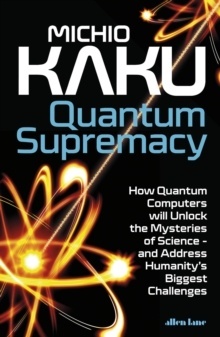Quantum Supremacy
How Quantum Computers will Unlock the Mysteries of Science and Address Humanity's Biggest Challenges

Editorial Penguin Books Ltd
Fecha de edición mayo 2023 · Edición nº 1
Idioma inglés
EAN 9780241555668
352 páginas
Libro
encuadernado en tapa dura
Dimensiones 156 mm x 240 mm
Resumen del libro
An exhilarating guide to the astonishing future of quantum computing, from The New York Times bestselling physicistThe runaway success of the microchip processor may be nearing its end, with profound implications for our economy, society and way of life, even leaving Silicon Valley as a new Rust Belt, its technology obsolete. Step forward the quantum computer, which harnesses the power and complexity of the atomic realm, and may be useful in solving humanity's greatest challenges from climate change, to global starvation, to incurable diseases. Humanity's next great technological achievement already promises to be every bit as revolutionary as the transistor and microchip once were.
Its unprecedented gains in computing power and unique ability to simulate the physical universe herald advances that could change every aspect of our lives. Corporations and whole nations are betting on quantum computing, hoping to exploit its power to design more efficient vehicles, create life-saving new drugs and streamline industries to revolutionize the economy. But this is only the beginning.
Quantum computers could allow us to finally create nuclear fusion reactors that produce clean, renewable energy without radioactive waste or threats of meltdown. They could help us crack the biological processes that generate natural, cheap fertilizer and enable us to feed the world's growing populations. And they could unravel the fiendishly difficult protein folding that lies at the heart of previously incurable diseases such as Alzheimer's, motor neurone disease and Parkinson's, helping us to live longer, healthier lives.
Told with Kaku's signature clarity and enthusiasm, Quantum Supremacy is the story of this exciting frontier and the race to claim humanity's future.
Biografía del autor
x{0026}lt;P x{0026}lt;B Michio Kaku,x{0026}lt;/B nacido en 1947 en California, Estados Unidos, de padres japoneses, es un eminente físico teórico y uno de los creadores de la teoría de campos de cuerdas. Apadrinado por Edward Teller, que le ofreció la beca de ingeniería Hertz, se formó en Harvard y en el Laboratorio Nacional Lawrence Berkeley de la Universidad de California, donde obtuvo el doctorado en física en 1972. Desde hace casi treinta años ocupa la Cátedra Henry Semat de Física Teórica en la Universidad de Nueva York y es uno de los divulgadores científicos más conocidos del mundo; presenta dos programas de radio y participa en espacios de televisión y documentales. Es autor además de decenas de artículos y de varios libros, algunos de ellos traducidos al castellano: x{0026}lt;I El universo de Einsteinx{0026}lt;/I (2005), x{0026}lt;I Universos paralelos x{0026}lt;/I (2008), x{0026}lt;I Física de loimposiblex{0026}lt;/I (2009), x{0026}lt;I El futuro de nuestra mentex{0026}lt;/I (2014), x{0026}lt;I La física del futuro x{0026}lt;/I (2011), x{0026}lt;I El futuro de la humanidadx{0026}lt;/I (2018) y x{0026}lt;I La ecuación de Diosx{0026}lt;/I (2022).x{0026}lt;/P








